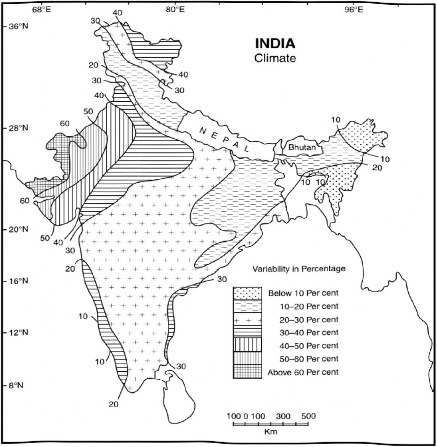VARIABILITY OF RAINFALL
The rainfall in India is highly variable. The actual rainfall of a place in a year deviates from its average rainfall by 10 to over 60 per cent. The mean annual variability of rainfall in India has been plotted in Fig. 4.21.

It may be noted from Fig. 4.21 that the highest variability is found in the areas where the average annual rainfall is the lowest For example, the desert areas of Barmer, Ganganagar, Jaisalmer, Jodhpur, etc. have less than 20 cm of average annual rainfall. In these areas the variability of rainfall is around 60 per cent.
Contrary to this, in the areas where the average annual rainfall is over 200 cm (Mawsynram and Cherrapunji, Meghalaya Plateau), the annual variability of rainfall is less than 10 per cent. The Western slopes of Western Ghats, the Lesser Himalayas, the Shiwaliks and the Tarai belt also record between 100-200 cm of average annual rainfall. The variability of rainfall in these regions is around 10 to 20 per cent. Thus, there is an inverse relationship between the average annual rainfall and variability in rainfall.
The variability of rainfall has a significant role in the agricultural operations and other economic activities of the country. The areas showing high variability of rainfall have chronic deficiency of water. Such regions are highly prone to droughts, floods and famines, while the areas with high average annual rainfall are less affected by droughts; though flood is a regular feature in flood prone areas.
